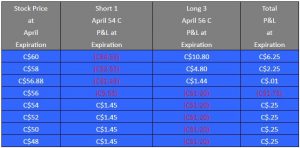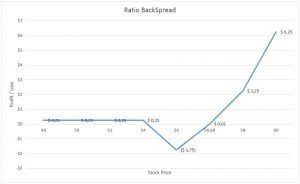Reverse Ratio Call Backspread

In a previous article, “Bull Call and Bear Put Spreads” investors learned how to construct a simple 1:1 vertical spread. This week we will discuss how a ratio spread can be implemented and the risks and benefits of this strategy. A ratio spread is similar to a vertical spread in that it involves the simultaneous purchase and sale of options of the same underlying and expiry. Unlike a 1:1 vertical spread the number of options contracts bought and sold is at a minimum 1:2 ratio, but the ratio can be greater depending on your forecast. There are no naked options as the long options always outnumber the short options.
Canadian investors with a forecast for greatly increasing volatility can use Ratio Backspreads to get volatility exposure without having to pay a debit for the spread. The Call Backspread involves the selling of an In-The-Money call while buying two or more higher strike Out-of The-Money call options. The backspreader is seeking a dramatic move in the underlying. The strategy will benefit greatly if the underlying rallies big, due to the extra long call(s), but it can also profit if it falls hard. These trades can be generally accomplished for even money or a credit depending upon the prices of the options and the strike selection. The long calls are for price appreciation, while the established credit hedges the downside.
Let’s look at an example:
SLF (Sun Life Financial) is trading at C$54.56 as March 9, 2018. The investor believes it will either fall below $54.65 or above $57.35 by 04/20/2018.
The investor sells a April 54 strike call for C$1.45 while buying three April 56 calls for C$0.40 (C$1.20 total). The credit is established for C$.25 (C$1.45-C$1.20=C$0.25).
Short 1 SLF April 20 expiry 54 Call + Long 3 April 20 expiry 56 Calls – SLF trading at C$54.56

Note, the maximum loss could occur at expiration with the underlying price trading at C$56 and Out-Of-Money calls worthless (C$1.75)
The maximum gain on the downside is the established credit or C$.25 while the maximum profit is unlimited!
The Break-Even is with the underlying closing at C$56.88 at expiration (C$.01)

The risk of early assignment exists for the In-The-Money short call option. This will not change the limited risk nature of the strategy prior to expiration as the investor is covered by the long options. However, at expiration the investor will want to close the strategy to avoid being naked short shares and additional margin requirements.
The Ratio Backspread is disadvantaged by the time-decay as the Out-The-Money long options are all composed of time value. Any increase in volatility has a positive effect, while any decrease in volatility is negative for this strategy. Tactically speaking, the strategy should be placed when volatility is historically low and the investor expects a huge volatile move in the underlying.
The Ratio Call Spread can also be constructed as a delta-neutral spread. In the example above, the delta for the April 54 Call is .6380 with a .3272 delta for each of the three April 56 Calls. The delta neutral ratio would then be 1.95:1, derived by dividing delta of the 54 call by the delta of the 56 call (.6380/.3272). The investor, in this case, would buy with a 2:1 ratio 4 of the 56 calls while simultaneously selling 2 of the 54 calls. A delta neutral strategy keeps the strategy from being either too bullish or too bearish. Remember, deltas and additional options Greeks can be found at https://www.m-x.ca/marc_options_calc_en.php
We will delve deeper into delta and gamma neutral trading in a later piece.
It is essential to point out that this strategy needs to be actively Managed, so it is only suitable for investors with ample options trading experience.
CEO
Grigoletto Financial Consulting
Alan Grigoletto is CEO of Grigoletto Financial Consulting. He is a business development expert for elite individuals and financial groups. He has authored financial articles of interest for the Canadian exchanges, broker dealer and advisory communities as well as having written and published educational materials for audiences in U.S., Italy and Canada. In his prior role he served as Vice President of the Options Clearing Corporation and head of education for the Options Industry Council. Preceding OIC, Mr. Grigoletto served as the Senior Vice President of Business Development and Marketing for the Boston Options Exchange (BOX). Before his stint at BOX, Mr. Grigoletto was a founding partner at the investment advisory firm of Chicago Analytic Capital Management. He has more than 35 years of expertise in trading and investments as an options market maker, stock specialist, institutional trader, portfolio manager and educator. Mr. Grigoletto was formerly the portfolio manager for both the S&P 500 and MidCap 400 portfolios at Hull Transaction Services, a market-neutral arbitrage fund. He has considerable expertise in portfolio risk management as well as strong analytical skills in equity and equity-related (derivative) instruments. Mr. Grigoletto received his degree in Finance from the University of Miami and has served as Chairman of the STA Derivatives Committee. In addition, He is a steering committee member for the Futures Industry Association, a regular guest speaker at universities, the Securities Exchange Commission, CFTC, House Financial Services Committee and IRS.
The information provided on this website, including financial and economic data, quotes and any analysis or interpretation thereof, is provided solely for information purposes and shall not be construed in any jurisdiction as providing any advice or recommendation with respect to the purchase or sale of any derivative instrument, underlying security or any other financial instrument or as providing legal, accounting, tax, financial or investment advice. Bourse de Montréal Inc. recommends that you consult your own advisors in accordance with your needs before making decision to take into account your particular investment objectives, financial situation and individual needs.
All references on this website to specifications, rules and obligations concerning a product are subject to the rules, policies and procedures of Bourse de Montréal Inc. and its clearinghouse, the Canadian Derivatives Clearing Corporation, which prevail over the content of this website. Although care has been taken in the preparation of the documents published on this website, Bourse de Montréal Inc. and/or its affiliates do not guarantee the accuracy or completeness of the information published on this website and reserve the right to amend or review, at any time and without prior notice, the content of these documents. Neither Bourse de Montréal Inc. nor any of its affiliates, directors, officers, employees or agents shall be liable for any damages, losses or costs incurred as a result of any errors or omissions on this website or of the use of or reliance upon any information appearing on this website.
BAX®, CADC®, CGB®, CGF®, CGZ®, LGB®, MX®, OBX®, OGB®, OIS-MX®, ONX®, SCF®, SXA®, SXB®, SXF®, SXH®, SXM®, SXO®, SXY®, and USX® are registered trademarks of the Bourse. OBW™, OBY™, OBZ™, SXK™, SXJ™, SXU™, SXV™, Montréal Exchange and the Montréal Exchange logo are trademarks of the Bourse. All other trademarks used are the property of their respective owners.
© 2024 Bourse de Montréal Inc. All Rights Reserved.
